YOU CAN SUBSTITUTE AN ATV FOR A SNOWMOBILE IN MOST OPERATIONS DESCRIBED IN THIS WEBSITE.

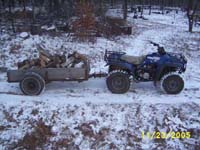

THE ORGINAL GOAL: Design a system of moving firewood out of the forest that is practical for the average person, requires the least investment in wood moving equipment, and does the least damage to the forest.
REVISED GOAL: When we first started getting firewood out of the forest we used an older snowmobile and a sled. This method worked really well, but over the last 30 years we have gone through a number of winters with very limited snowfall. This made getting firewood out more difficult because we had to work around the limited snow conditions. Since then we have replaced the snowmobile with an older ATV. The ATV can use either a trailer or a sled. The original sled used with the snowmobile works well if the trailer hitch is lengthened to make sure you have a better turning radius for the ATV. In changing to an ATV we found we had to make only minor adaptions to the snowmobile sled firewood system. Trail design was essentially the same except we found a slight widening of trails helped in some situations. Given the current trend towards less dependable snowfall in the northern states, we now recommend transitioning to ATV instead of snowmobiles.
NOTE: UNTIL THIS WEBSITE IS UPDATED TO REFLECT THE CHANGE FROM SNOWMOBILE TO ATV:
YOU CAN SUBSTITUTE AN ATV FOR A SNOWMOBILE IN MOST OPERATIONS DESCRIBED IN THIS WEBSITE.

PROPOSED SYSTEM: Using a chain saw, an older ATV with a trailer or homemade sled (or if you have enough snow in the winter an older snowmobile and a home made sled), this system allows an average person to move approximately 500 lbs. per sled load of green cut firewood along snowmobile trails. ATV and Snowmobile trails are less work to make and maintain than roads and avoid the problems associated with road maintenance (mud, ruts, culverts, soil erosion, etc.). Older ATV's (starting around $1,000) or Older snowmobiles (1970's - 80's) cost less (starting around $500+) than older pickup trucks or tractors (at $2,000+). By moving wood in the winter you can take advantage of the snow to make good trails even over rough terrain. The less friction provided by the snow allows a low horse power engine (about 20 hp) to carry a good size load (approximately 1/3 face cord = 500 lbs = 1/4 ton) on very narrow, low maintenance trails.
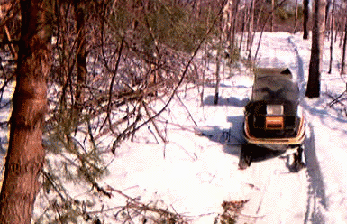
The key to this system is careful attention to snow and weather conditions. Before the snow falls go through your forest and mark a trail. Try to avoid areas with large rocks or stumps. Clear obvious obstacles, such as logs, stumps, etc. for the width of the trail (about 4 feet wide). Plan to cut heavily in a small area of your forest. A heavy selective cutting will take no more volume of firewood than will grow back in about 10 years. (See your local state forester for details on sustainable yield cutting where cutting does not exceed rate of regrowth). Make the trail so you can be near the trees you want to cut and have the least distance to drag the wood to the trail. Mark selected trees within about 100 feet of either side of the trail. When possible fall the marked trees towards (but not on) the snow trail. It's best to have your snow trails cleared before the 1st snow fall so you'll know there's nothing that could damage the track of the snowmobile under the snow.

Effective use of this system depends on careful timing of activities according to the snow and weather conditions. Break trails with an unloaded snowmobile before the snow gets too deep for easy passage. (Depending on snowmobile and conditions this may be about 6" of wet snow). You can either make a wide loop of 2 trails (one going out and one coming back) or you can have a single trail with a turn around at the end. (A double trail with a wide loop can harvest from an area about 400' wide.) If you make a single trail you can make a loop at the end of the trail that allows the snowmobile to turn around, using the minimum turning radius of the snowmobile (see picture above). The single trail method is useful for getting into difficult to access areas where the snowmobile and sled will go to the end of the trail, turn the loop, and you will pick up wood on the return trip. Once the trail is broken allow the trail to harden (overnight) so the snow will provide the best support for the snowmobile and a fully loaded sled. Below freezing provides the best trail conditions and allows the maximum load. Above freezing conditions are not recommend for moving wood as the track of the snowmobile slips on the slushy snow, and load size is reduced and trails are damaged.
Plan your work schedule around trail conditions. For example, if morning temperatures are below freezing and the trail is in good shape, then move wood. When trails get too warm for good sized loads, then cut wood for moving the following morning when trail conditions may be better. A good hard snow trail provides low friction passage for the wood load, with very little loss of trail quality. It is well worth the effort (and much less work) if you plan carefully.
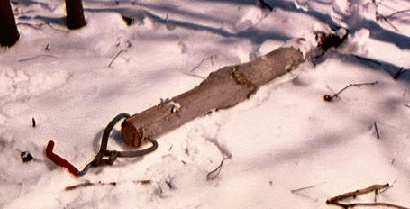
Once the trees are cut down we trim the branches and cut the wood to length. If the tree is near the trail we block the wood into stove length (see what fits in your stove: we use 16" as a stove length). Once the wood is cut to stove length it is throw to the edge of the trail for pick up. When deciding where locate the pick up areas avoid places where the snow trail is going up hill. Level or down hill slopes make start up easier. Setting up the sled to cause the minimum load on the snowmobile when it starts up [Setting Up Sled For Least Load At Start Up] is an important consideration in this method of moving wood.
Trees that are some distance from the trail are not cut to stove length because they are much easier to handle if left in log length. If a tree is not near enough to the trail to throw a stove length piece of wood to the edge of the trail in one throw then we cut it into an easy to handle log length. The log can then be dragged to the trail where it can be cut to stove length beside the trail. Heavy logs (12" diameter and up) may need to be cut to short logs (2 to 3 stove lengths long) so one person can drag them to the trail. Smaller logs may be cut to longer logs lengths (4 to 6 or more stove lengths) to drag to the trail to process further.
A log puller (see log puller) is a really valuable tool for moving logs in the woods. We find that the ability to put a handle on a log and drag it to the trail is a real labor saver. Dragging a log allows you to carry only a small amount of the weight of the log because the other end is dragged in the snow. We use the same trail to drag a number of logs and it gets easier the more you use the trail. Some people have used an old pair of ice tongs as a substitute, but a log puller works best. Really small logs (poles) may be easier to move by hand or in a toboggin to get them to the trail. Straight pole size (3-4" dia) hardwood (cedar or locust is better) is worth saving in log length to use to stack your wood on in the stacking area near your house .
We believe that cutting trees safely requires building good safe work habits, paying attention to small details, and frequent rests. We try to avoid cutting for long periods without breaks and we like to alternate between jobs like cutting trees, dragging logs, cutting wood to length, and loading the sled. Planning short breaks allows a person to look over their work before starting to cut again. We believe cutting when you are rested and able to give full attention to your work will help avoid problems and add to the enjoyment of the work.
If you are not experienced with a chain saw, DO NOT go out and start cutting. Get an experienced cutter to work with you and show you how to use a saw safely. Read your saw manual. Educate your self on safety and never do any cutting you are not comfortable with. If you are a beginner, you might want to consider starting by having some else cut the trees down, so you can learn to cut trees that are already cut down, first.
In this report we are merely presenting some methods we have used and some that are commonly used in our area. They are presented for your consideration. You must decide what aspects (if any) of the methods outlined here might apply to your situation. Since we have no knowledge of your experience and the special circumstance of your environment we do not recommend that any method presented here be used by any one. After careful consideration, you must decide what to do for yourself.
WE CAN NOT BE HELD RESPONSIBLE FOR YOU USING ANY METHOD OUTLINED HERE, because we NOW CLEARLY STATE that we hereby WARN you NOT to imitate or use any method presented in this report. This applies to all aspects of this report and includes (but is not limited to) references to chain saws, snowmobile, sled, tools and any other potential danger. We have tried to point out the dangers that we are aware of in the work outlined here based on our experience, but there may be more dangers than we are aware of. This report is intended to present for consideration a system for moving wood out of the forest and it is NOT intended as an instruction on the safe use of a chain saw or cutting methods or the safe use of a snowmobile.
Remember a few years ago major fast food chains were sued for selling hot coffee and for not adequately warning customers that hot coffee could be HOT!
Enough said ... You HAVE BEEN WARNED. (Now the lawyers should be happy.)
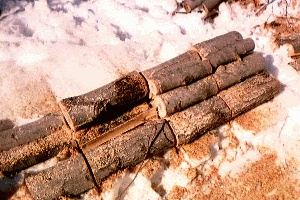
Once we get the wood to the trail then we find it convenient to stack the wood to cut more than one piece at a time. Remember this is one of those methods we do not recommend you use. [Warning: Read The Safety Section].We use it because we are experienced chain saw users and we know our conditions. We started trying this method by laying one log on deep snow (12") after we made sure no obstacles were underneath (see below). We are very careful not to cut below the snow line. After we got used to that we added a second log so we could cut 2 logs beside each other at one time. This does not work well with small diameter logs because they can jump around while you are cutting and present a real hazard. We never use the point of the saw to cut. After we felt comfortable cutting 2 logs together, we tested 3 log stacks. We found logs must be good sized to remain in place and stacked very carefully. We never stack logs with the bow in the log lifting the log up. This is especially important in the top log. We stack so any bow in the log raises the ends of the logs up. Experienced wood cutters know, if the bow in the log lifts the log up, then the saw will bind as it cuts through the log and binding the saw is not something you want to do. At the very least it can stop the saw cutting and it can easily cause other hazards, like loss of control of the saw. So we found that the step from 2 to 3 logs was a big step. You need to be able to avoid all problems with bows in the wood. See in the pictures the advanced stack included a 3 bottom and 2 top pile. We do not recommend this method to anyone (See Disclaimer) because bowing in the wood is even more of a potential problem.
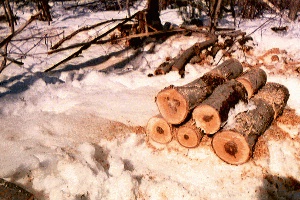
The photo shows a cut out view of the snow under the stacked wood. We have about a foot of snow under this pile and no rocks or other obstructions. The decision as to when or if to use this method is a case where you have to know your environment and your level of skill. For example if you have a lot of rocks hidden under the snow this could be a real problem. We make sure the snow is deep and check for rocks, logs and other hazards under the snow, and we cut level, never cutting down into the snow or with the end of the saw. Hitting a rock under the snow can take a big chunk out of your chain (if it doesn't ruin the chain can take a big chunk out of the chains life because you have to file the each cutter down to the level it takes to get rid any sign of damage to the worst effected cutter). Believe me any damage to a chain causes it cut in erratic ways, so be prepared to file to the level needed to remove the damage or replace the chain. But worse than chain damage is that hitting something under the snow can cause chain derailment, flying metal (extreme), or loss of control. So we try to avoid this danger by careful planning.